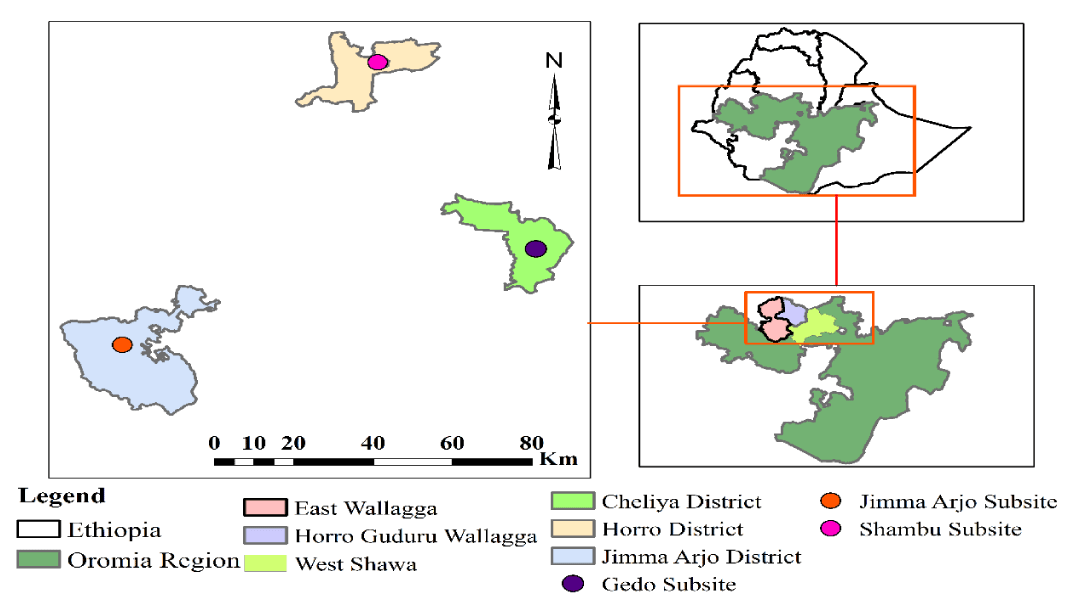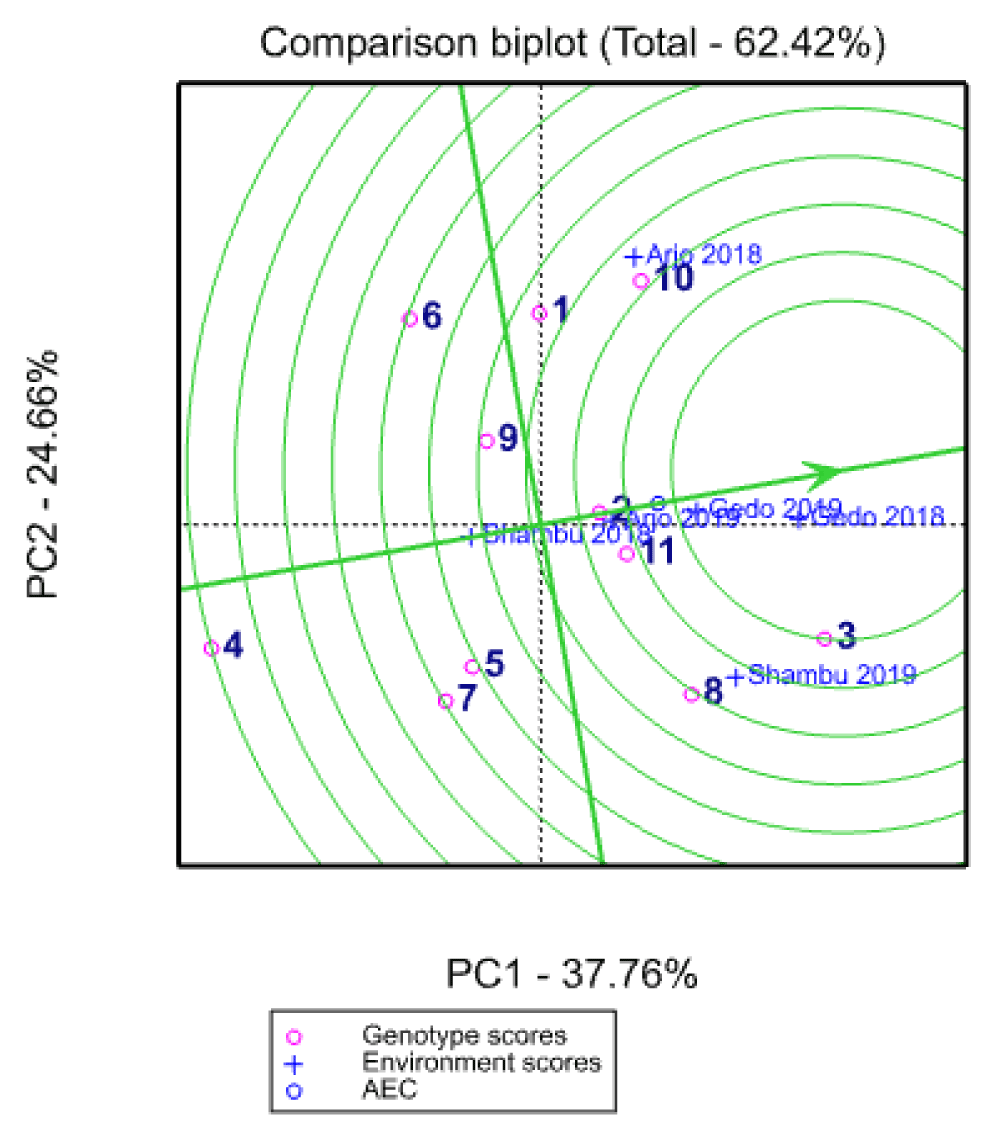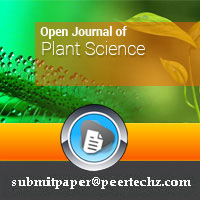Open Journal of Plant Science
Registration of “KUULLEE” field pea (Pisum sativum L.) variety (Shiro Type) for large-scale farmers
Solomon Bekele1* and Chala Debela2
2Bako Agricultural Research Center, P.O Box: 03 Bako, Oromia, Ethiopia
Cite this as
Bekele S, Debela C. Registration of “KUULLEE” field pea (Pisum sativum L.) variety (Shiro Type) for large-scale farmers. Open J Plant Sci. 2024;9(2): 021-025. Available from: 10.17352/ojps.000061Copyright
© 2024 Bekele S, et al. This is an open-access article distributed under the terms of the Creative Commons Attribution License, which permits unrestricted use, distribution, and reproduction in any medium, provided the original author and source are credited.KUULLEE (EH08027-2) field pea variety is an improved variety selected from eleven pipelines including standard check LAMMIIF during the trial was undertaken at three test locations (Gedo, Shambu, and Arjo) in randomized Complete Block Design with three replications. The study was conducted with the objectives of releasing a variety that is high yield, disease resistant, and stable than the other competent genotypes from 2016-2020 for five consecutive years. The accessions originated first from the Field Pea Center of Excellence (Holetta Agricultural Research Center). The new variety, KUULLEE (2795.23 kg ha-1) was 10.15% yield advantages over the standard check LAMMIIF (2537.5 kg ha-1). KUULLEE variety is mainly used for the “SHIRO type”. The GGE revealed that EH08027-2 or KUULLEE variety is high-yielding, stable, and moderately resistant to Blotch, Downy Mildews, and Powdery Mildews field pea disease. Therefore, the KUULLEE variety was officially released in 2021 for Western Oromia and similar agro-ecologies.
Introduction
Field pea (Pisum sativum L.), a legume crop, belongs to the Leguminosae family and contains a high amount of protein including amino acids, especially lysine [1]. Field pea (Pisum sativum L.) is one self-pollinated diploid (2n = 14, x = 7) annual of the most important annual cool season pulse crop and is valued as high protein food [2]. It is one of the most important pulse crops produced in the highlands of Ethiopia and the world by smallholder farmers. Due to field peas are rich in protein, significantly used as animal meat products in most developing countries including Ethiopia, and also used in the cropping systems for soil fertility improvement [3]. In the 2017/2018 cropping season, 220,508.39 ha of land was covered with field peas, and the annual production was estimated at 3,685,190.65 quintals in Ethiopia [4]. Because of filed pea production limiting factors in the world and Ethiopia, like the use of the local variety, disease, aphids, lodging, and shattering, the reported average yield in T ha-1 was 1.9 T ha-1 in the world [5] and 0.85 in Ethiopia [6] respectively. In Ethiopia, the annual consumption of pea seeds per person is estimated at 6-7kg. Main dishes include ‘shiro wot’ (split pea seeds ground and made into stew), mainly not dissected but rather disintegrated to the powder and sweets, and Snacks include ‘eshet’ (fresh green field pea seeds eaten either raw or roasted), ‘nifro’ (boiled dry or fresh green pea seeds) and ‘endushdush’ (seeds soaked first and then roasted). In local markets, grey-colored field pea seeds are preferred for ‘shiro’ making [4]. Bako Agricultural Research Center released one ‘Shiro’ type field pea variety called LAMMIIF in 2017; and this year, (2021) KUULLEE variety will be registered as the second Shiro type field pea variety with Bako Agricultural Research Center as a maintainer.
Materials and methods
Description of study areas
The experiment was carried out in three field pea-growing environments during the 2018 and 2019 main cropping seasons in Ethiopia. The environments were as follows: Shambu, Gedo, and Arjo (Figure 1). The test environments were selected based on the representativeness of field pea-producing environments. These six locations represent different agro-ecologies of field pea-growing areas in Ethiopia and descriptions of the areas are on the bellow map.
Experimental materials and design
Ethiopian field pea landraces collected from the Holeta Agricultural Research Center were evaluated along with check LAMMIIF. The best-performed Candidate Genotype (EH08027-2) was evaluated with standard check LAMMIIF based on yield performance and disease resistance. The experiment was conducted using three locations and farmers’ fields on a10mx10m area of plots. The seeds were planted on the first week of July on settled plots with an inter-row spacing of 20 cm and 5 cm between seeds within the row. The spacing between plots and blocks was 1m. All agronomic management practices were carried out equally and properly as per the recommendations. Finally the following.
Data collected
Data for plant height, number of pods per plant, and number of seeds per pod were collected based on five sample plants which were randomly taken from the two central rows, and the average of five samples was used for analysis, while days to 50% flowering, days to 90% maturity, grain yield, and 100 seed weight were collected based on the net plot.
Data analysis
Different statistical software packages were used to analyze the data. SAS 9.2 was used for analysis of the variance of the individual environments and combined over locations. Various stability analyses were computed for grain yield. Mean comparison using Duncan’s Multiple Range Test (DMRT) was performed to explain the significant differences among the means of genotypes and environments.
Results and discussions
Varietal origin and evaluation
The source of the KUULLEE (EH08027-2) field pea variety was the Holetta Agricultural Research Center. KUULLEE variety was evaluated alongside 9 field pea pipelines and one standard check LAMMIIF for two consecutive years at the regional Variety Trial (RVT) stage (2018 and 2019) at Arjo, Gedo, and Shambu research stations.
Agronomic and morphological characteristics
The newly released Shiro-type field pea variety, KUULLEE characterized by a brown irregular shape. The variety has an average of 17.27 gm of hundred seed weight, 63.16 days to flowering, 122.61 days to mature, and 168.53 cm of plant height. This variety was also moderately resistant to Blotch (2.77) and powdery and downy mildew (1.77) diseases. The detailed description of KUULLEE variety characteristics is indicated in Tables 1 and 2 below.
ANOVA for shiro type field pea crop varieties
Yield performance: The pooled grain yield performance of the KUULLEE field pea variety is 2795.23 kg/ha and the variety was mainly well performed at Gedo (3769 kg/ha) followed by Shambu (2960.5 kg/ha) and finally 1656.2 kg/ha at Arjo; this was primarily raised from soil fertility status difference of the three test locations. Generally, the variety has 10.15% yield advantages over standard check LAMMIIF. The detailed performances of the evaluated genotypes are listed in the following Tables 3 and 4.
Disease reaction of the candidate genotypes
Among the genotypes tested genotype (EH08027-2) is moderately resistant to Blotch (2.77) and powdery and downy mildews (1.77) diseases Reaction of Major Diseases (Table 5).
GGE-Biplot analysis
The ranking of genotypes based on yield and stability: The GGE-biplot analysis of Shiro-type field pea-tested varieties showed that, four genotypes: EH08027-2, EH08027-1, EH08013-2, and EH04047-1 have better yield performance than the standard check, LAMMIIF with 2795.25 (10.15%), 2700 (6.4%), 2694.07 (6.17%) and 2648.63 (4.3%) in both kg ha-1 and percentage respectively. Both PC1 and PC2 were separated based on their scores for eleven Shiro-type field pea-tested varieties in the study area (Figure 2).
The primary use of the GGE-biplot is grading the tested genotypes for the locations. PC1 indicated the mean performance of the varieties while PC2 indicated the G X E associated with each genotype which is the measure of stability or instability [7,8]. Genotypes having PC1 > 0 were recognized as high yielding while those genotypes having PC1 score < 0 were identified as low yielding, [9]. A KUULLEE variety (EH8027-2) or treatment 3 is more stable than other tested field pea varieties and gives higher yield and environment The 2018 season is the best year for the production of field pea crops (Table 6).
The grain yield stability of the 11 treatments was evaluated across three environments for two consecutive years. The result revealed that the EH08027-2 candidate variety was placed nearest to the first circle of the GGE biplot of the diagram than standard check LAMMIIF and other tested genotypes. This showed that the EH08027-2 candidate variety had better stability and high yielder than LAMMIIF and the rest of the genotypes. The stability and GGE-biplot diagrams are sketched below (Figure 2).
Conclusion
Classification of field pea varieties depends on the purpose of utilization is very useful to boost the satisfaction of the users in one or another case on the same commodity. The KUULLEE field pea variety was widely adapted, and stable and showed higher yield performance than the standard check and the other tested pipeline field pea genotypes. Generally, GGE biplot analysis results revealed that KUULLEE (EH08027-2) is a stable and high-yielding (2795.25 kg ha-1 ) field pea variety with 10.15% yield advantage over the best standard check, LAMMIIF (2537.5 kg ha-1 ) and also tolerant to major diseases. Therefore, it was officially released for wider production in west Oromia and areas with similar agro-ecologies.
The authors acknowledge the Oromia Agricultural Research Institute for funding the project. His praise also extended to Bako Agricultural Research Center for the Coordination of the Research Project and logistic facilitates during field trials at respective locations. Pulse technology generation research team members of Bako Agricultural Research Center are highly acknowledged for their contribution during field experimentations.
- Nawab NN, Subhani GM, Mahmood K, Shakil Q, Saeed A. Genetic variability, correlation and path analysis studies in garden pea (Pisum sativum L.). J Agric Res. 2008;46(4):333-40. Available from: https://www.cabidigitallibrary.org/doi/full/10.5555/20093106340
- McKay K, Schatz B, Endres G. Field pea production. Production. 2003;1166:1-8. Available from: https://agresearch.montana.edu/wtarc/producerinfo/agronomy-nutrient-management/Pulses/NDSUFactSheet.pdf
- Kandel H, Mcphee K, Akyüz A, et al. North Dakota Dry Pea Variety Trial Results for 2016 and Selection Guide. Fargo (ND): NDSU Extension Service; 2016.
- Ministry of Agriculture. Crop Variety Register Issue No. 21. Addis Ababa (Ethiopia): Plant Variety Release, Protection and Seed Quality Control Directorate; 2018.
- Rubiales D, González Bernal MJ, Warkentin T, Bueckert T, Vaz Patto MC, McPhee K, et al. Advances in pea breeding. In: Hochmuth G, editor. Achieving sustainable cultivation of vegetables. Cambridge (UK): Burleigh Dodds Science Publishing; 2019. Available from: https://novaresearch.unl.pt/en/publications/advances-in-pea-breeding
- CSA (Central Statistical Agency). Agricultural Sample Survey 2015/2016 Volume I Report on Area and Production of Major Crops. Addis Ababa (Ethiopia): Central Statistical Agency; 2016. Available from: https://www.scirp.org/reference/referencespapers?referenceid=2611372
- Yan W, Hunt AL, Sheng Q, Szlavnics Z. Cultivar evaluation and mega-environment investigation based on GGE-biplot. Crop Science. 2000;40(3):597-605. Available from: https://doi.org/10.2135/cropsci2000.403597x
- Yan W. Singular-Value Partitioning in Biplot Analysis of Multienvironment Trial Data. Agron J. 2002;94(5):990-996. Available from: http://dx.doi.org/10.2134/agronj2002.9900
- Kaya Y, Ackura M, Taner S. GGE-biplot analysis of multi-environment yield trials in bread wheat. Turkish Journal of Agriculture. 2006;30:325-37. Available from: https://journals.tubitak.gov.tr/agriculture/vol30/iss5/3/
Article Alerts
Subscribe to our articles alerts and stay tuned.
 This work is licensed under a Creative Commons Attribution 4.0 International License.
This work is licensed under a Creative Commons Attribution 4.0 International License.




 Save to Mendeley
Save to Mendeley
